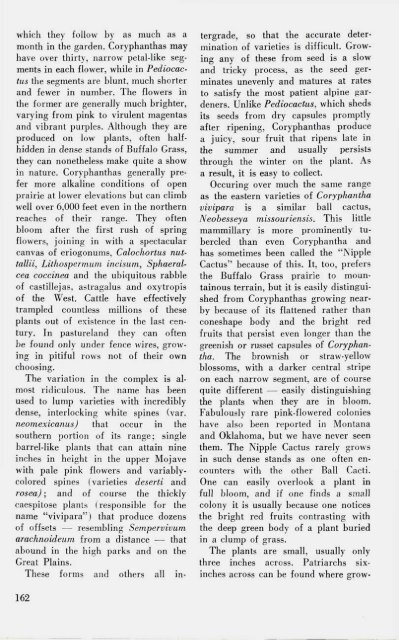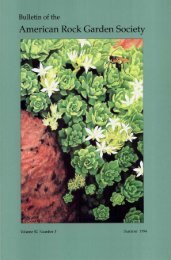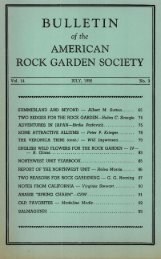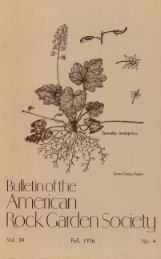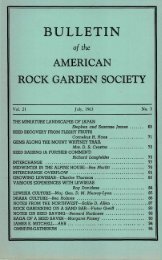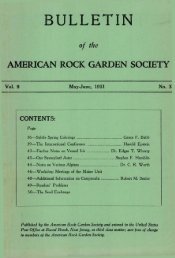Bulletin - Fall 1979 - North American Rock Garden Society
Bulletin - Fall 1979 - North American Rock Garden Society
Bulletin - Fall 1979 - North American Rock Garden Society
Create successful ePaper yourself
Turn your PDF publications into a flip-book with our unique Google optimized e-Paper software.
which they follow by as much as amonth in the garden. Coryphanthas mayhave over thirty, narrow petal-like segmentsin each flower, while in Pediocactusthe segments are blunt, much shorterand fewer in number. The flowers inthe former are generally much brighter,varying from pink to virulent magentasand vibrant purples. Although they areproduced on low plants, often halfhiddenin dense stands of Buffalo Grass,they can nonetheless make quite a showin nature. Coryphanthas generally prefermore alkaline conditions of openprairie at lower elevations but can climbwell over 6,000 feet even in the northernreaches of their range. They oftenbloom after the first rush of springflowers, joining in with a spectacularcanvas of eriogonums, Calochortus nuttallii,Lithospermum incision, Sphaeralceacoccinea and the ubiquitous rabbleof castillejas, astragalus and oxytropisof the West. Cattle have effectivelytrampled countless millions of theseplants out of existence in the last century.In pastureland they can oftenbe found only under fence wires, growingin pitiful rows not of their ownchoosing.The variation in the complex is almostridiculous. The name has beenused to lump varieties with incrediblydense, interlocking white spines (var.neomexicanus) that occur in thesouthern portion of its range; singlebarrel-like plants that can attain nineinches in height in the upper Mojavewith pale pink flowers and variablycoloredspines (varieties deserti androsea); and of course the thicklycaespitose plants (responsible for thename "vivipara") that produce dozensof offsets — resembling Sempervivumarachnoideum from a distance — thatabound in the high parks and on theGreat Plains.These forms and others all intergrade,so that the accurate determinationof varieties is difficult. Growingany of these from seed is a slowand tricky process, as the seed germinatesunevenly and matures at ratesto satisfy the most patient alpine gardeners.Unlike Pediocactus, which shedsits seeds from dry capsules promptlyafter ripening, Coryphanthas producea juicy, sour fruit that ripens late inthe summer and usually persiststhrough the winter on the plant. Asa result, it is easy to collect.Occuring over much the same rangeas the eastern varieties of Coryphanthavivipara is a similar ball cactus,Neobesseya missouriensis. This littlemammillary is more prominently tubercledthan even Coryphantha andhas sometimes been called the "NippleCactus" because of this. It, too, prefersthe Buffalo Grass prairie to mountainousterrain, but it is easily distinguishedfrom Coryphanthas growing nearbybecause of its flattened rather thanconeshape body and the bright redfruits that persist even longer than thegreenish or russet capsules of Coryphantha.The brownish or straw-yellowblossoms, with a darker central stripeon each narrow segment, are of coursequite different —• easily distinguishingthe plants when they are in bloom.Fabulously rare pink-flowered colonieshave also been reported in Montanaand Oklahoma, but we have never seenthem. The Nipple Cactus rarely growsin such dense stands as one often encounterswith the other Ball Cacti.One can easily overlook a plant infull bloom, and if one finds a smallcolony it is usually because one noticesthe bright red fruits contrasting withthe deep green body of a plant buriedin a clump of grass.The plants are small, usually onlythree inches across. Patriarchs sixinchesacross can be found where grow-162


